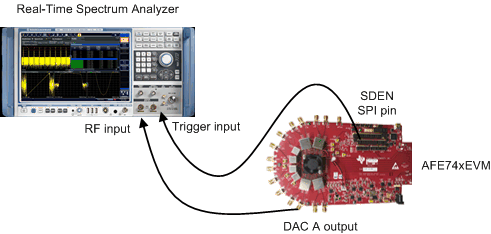SLAA870 February 2019 AFE7422 , AFE7444
-
Evaluating the frequency hopping capability of the AFE74xx
- Trademarks
- 1 Introduction
- 2 Phase Coherency vs Phase Continuity
- 3 AFE74xx Architecture
- 4 Frequency Hopping Methods
- 5 NCO Frequency Resolution Versus Hop Time
- 6 Fast Frequency Hopping With the Load and Switch
- 7 Register Addresses
- 8 References
4.2.1.2.1 Hardware Setup
Measuring the settling time for the AFE74xx DACs requires a spectrum analyzer capable of real-time, frequency-domain analysis. As shown inFigure 19, the spectrum analyzer is connected to the DAC A SMA output labeled I_OUTA on the AFE74xxEVM. The SPI clock on the AFE74xxEVM is the trigger source for the spectrum analyzer as the AFE74xx active TX NCO switches from TXNCO0 to TXNCO1.
 Figure 19. DAC Settling Time: Hardware Setup
Figure 19. DAC Settling Time: Hardware Setup